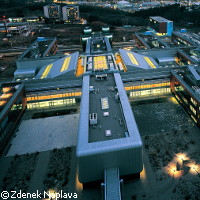SYNBIOSIS promotes solid European research ties
Synergies that fuel the European Research Area (ERA) also promote the scientific development of regions across the EU. Enter the SYNBIOSIS ('Maximising synergies for central European biotech research infrastructures') project that has brought together two research-driven clusters (RDCs) - Friuli Venezia Giulia (Italy) and South Moravia (Czech Republic) - that are active in diverse research fields including bioinformatics, computational biology and biomedicine. SYNBIOSIS has received almost EUR 940,000 under the 'Regional' priority of the Seventh Framework Programme (FP7), as the first-ever project coordinated from the Czech Republic, to establish trans-regional actions resulting in a Joint Action Plan that will respond to the needs and opportunities identified, and will fuel research-driven economic growth in both regions. The SYNBIOSIS partners said they will reflect and integrate synergies, good practices, expert recommendations and complementarities with financial plans. 'Special attention will be paid to the search for complementarities between the proposed actions and the EC regional policy programmes, creation of synergies between FP7 and Structural Funds, and an effective combination of public and private sources of funding,' the partners said in a statement. In Friuli Venezia Giulia, the construction of an advanced research infrastructure - FERMI@Elettra, a part of ESFRI (European Strategy Forum on Research Infrastructures) Roadmap - is currently being completed with its opening planned for the year 2011. This infrastructure is hosted within the premises of AREA Science Park, the leading science and technology park in the Friuli Venezia Giulia region. Officials in South Moravia, the Czech Republic, for their part, are laying out the groundwork to get its new research infrastructure - CEITEC (Central European Institute of Technology), ICRC (International Centre of Clinical Research), and the campus of Masaryk University - up and running. Most of the funding for the new research infrastructure in South Moravia will come from the 'Research and Development for Innovations Operational Programme' of the EU Structural Funds, which will bring subsidies of CZK 63.4 billion (EUR 2.4 billion) to the Czech Republic. It is pivotal that the Italian and Czech research infrastructures be properly integrated with each respective local economy. 'Their use must be coordinated and optimised in terms of performance and efficiency, so that the research infrastructure benefits the regional economies,' according to SYNBIOSIS coordinator Zlatuse Novotná from the South Moravian Innovation Centre. Officials noted the preparatory work for the Brno-based CEITEC has been completed. They anticipate the construction and operation of CEITEC at the end of 2010 following approval at the national and EU levels. Masaryk University Rector Petr Fiala commented on the CEITEC project, saying: 'We're submitting a project, which has been several years in preparation, so that we can use the advantages that Brno offers as a university town in building an excellent European funded research centre. The research which will be carried out at CEITEC will improve quality of life and bring advances in human health.' For his part, Brno University of Technology Rector Karel Rais said: 'The main idea is to provide our best scientific teams with the cutting-edge technologies, and make sure that they have working conditions at a normal level for a European research centre. We want to take research in Brno to a new level.' Under the project plans, a 1,200 MHz nuclear magnetic resonance spectrometer (NMR) will be available at CEITEC. In a statement, CEITEC officials said the machine, with a price tag of CZK 200 million (EUR 7.7 million), will enable researchers to study macromolecules in the same environment as they are in living organisms. One of the potential uses of this machine is the treatment of tumours. The institute will also house a high-definition transmission electron microscope enabling researchers to evaluate small preparations at high resolution and magnification, the officials said. 'The microscope, worth around CZK 90 million [EUR 3.46 million], allows magnification up to 100 nanometres. There are only a few of these microscopes in the world,' they added. When it becomes operational, CEITEC will be home to more than 800 leading scientists in the first 5 years of its launch. Thanks to the institute's state-of-the-art instruments and technologies, researchers will produce better and faster results. Their work will target, among others, biomaterials, robotic systems and distance therapy (i.e. improved functionality of rehabilitation equipment). 'Real research and development outcomes are expected right from the initial phases of operation,' explained CEITEC project director, Tomás Hruda. South Moravia, with a population of 1.2 million, represents the second largest concentration of research and development (R&D) in the Czech Republic. Almost 11,000 people are currently employed in the R&D sector, and 7,000 are researchers.
Countries
Czechia, Italy



